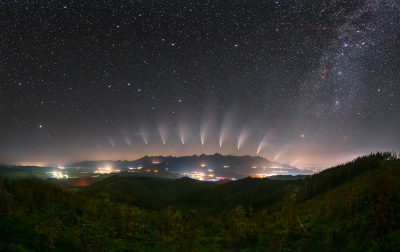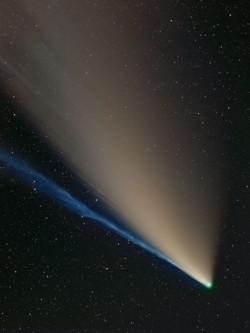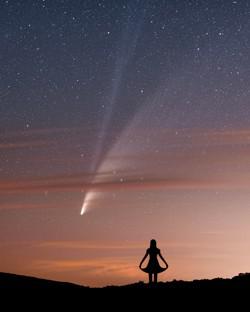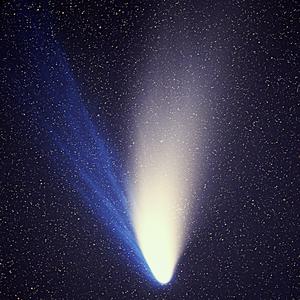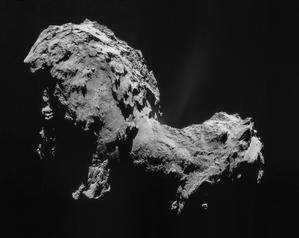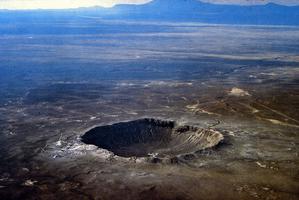Glossary term: Cometa
Description: Um cometa é um pequeno objeto no Sistema Solar que consiste em um núcleo formado por uma mistura de diferentes tipos de gelo e material rochoso e empoeirado - uma bola de neve suja. O tamanho dos núcleos dos cometas pode variar de algumas centenas de metros a dezenas de quilômetros de diâmetro. A maioria dos cometas tem órbitas altamente elípticas. Quando o cometa se aproxima do Sol, parte do gelo da superfície evapora e é soprado de volta pelo vento solar para formar as características distintas de coma e cauda. Vemos os cometas devido ao reflexo da luz solar na coma ou na cauda ou (no caso de cometas distantes do Sol) no núcleo. Os cometas são classificados como "periódicos" ou "de curto período" se sua passagem tiver sido observada mais de uma vez ou se seu período for conhecido como inferior a 200 anos, e como "não periódicos" caso contrário.
Related Terms:
See this term in other languages
Term and definition status: The original definition of this term in English have been approved by a research astronomer and a teacher The translation of this term and its definition is still awaiting approval
The OAE Multilingual Glossary is a project of the IAU Office of Astronomy for Education (OAE) in collaboration with the IAU Office of Astronomy Outreach (OAO). The terms and definitions were chosen, written and reviewed by a collective effort from the OAE, the OAE Centers and Nodes, the OAE National Astronomy Education Coordinators (NAECs) and other volunteers. You can find a full list of credits here. All glossary terms and their definitions are released under a Creative Commons CC BY-4.0 license and should be credited to "IAU OAE".
If you notice a factual or translation error in this glossary term or definition then please get in touch.
Related Media
Neowise's metamorphosis, by Tomáš Slovinský and Petr Horálek, Slovakia
Credit: Tomáš Slovinský and Petr Horálek/IAU OAE
License: CC-BY-4.0 Creative Commons Attribution 4.0 International (CC BY 4.0) icons
Comet C/2020F3 (Neowise) with separate dust and ion gas tails and a green glowing coma, by Dietmar Gutermuth, Germany
Credit: Dietmar Gutermuth/IAU OAE
License: CC-BY-4.0 Creative Commons Attribution 4.0 International (CC BY 4.0) icons
Hello Comet, shall we dance?, by Robert Barsa, Slovakia
Credit: Robert Barsa/IAU OAE
License: CC-BY-4.0 Creative Commons Attribution 4.0 International (CC BY 4.0) icons
Comet Hale-Bopp
Credit: E. Kolmhofer, H. Raab; Johannes-Kepler-Observatory, Linz, Austria credit link
License: CC-BY-SA-3.0 Creative Commons Attribution-ShareAlike 3.0 Unported icons
Comet 67P/Churyumov-Gerasimenko
Credit: ESA/Rosetta/NAVCAM credit link
License: CC-BY-SA-3.0-IGO Creative Commons Attribution-ShareAlike 3.0 IGO icons
Related Activities
Meteoroids, Meteors and Meteorites
astroEDU educational activity (links to astroEDU website) Description: Unveiling the mystery of "shooting stars": meteors, meteorites and meteroids
License: CC-BY-4.0 Creative Commons Attribution 4.0 International (CC BY 4.0) icons
Tags:
Geology
Age Ranges:
6-8
, 8-10
, 10-12
, 12-14
Education Level:
Middle School
, Primary
Areas of Learning:
Interactive Lecture
Costs:
Low Cost
Duration:
1 hour 30 mins
Group Size:
Group
Skills:
Analysing and interpreting data
, Asking questions
, Communicating information
, Engaging in argument from evidence
Measuring the average speed of a comet
astroEDU educational activity (links to astroEDU website) Description: Using telescope images of comet C/2019 Y4 we calculate its average speed and understand what a physical quantity is
License: CC-BY-4.0 Creative Commons Attribution 4.0 International (CC BY 4.0) icons
Tags:
Software
, average speed
Age Ranges:
12-14
, 14-16
, 16-19
, 19+
Education Level:
Secondary
Costs:
Free
Duration:
1 hour 30 mins
Group Size:
Group
Skills:
Analysing and interpreting data
, Developing and using models
, Engaging in argument from evidence
